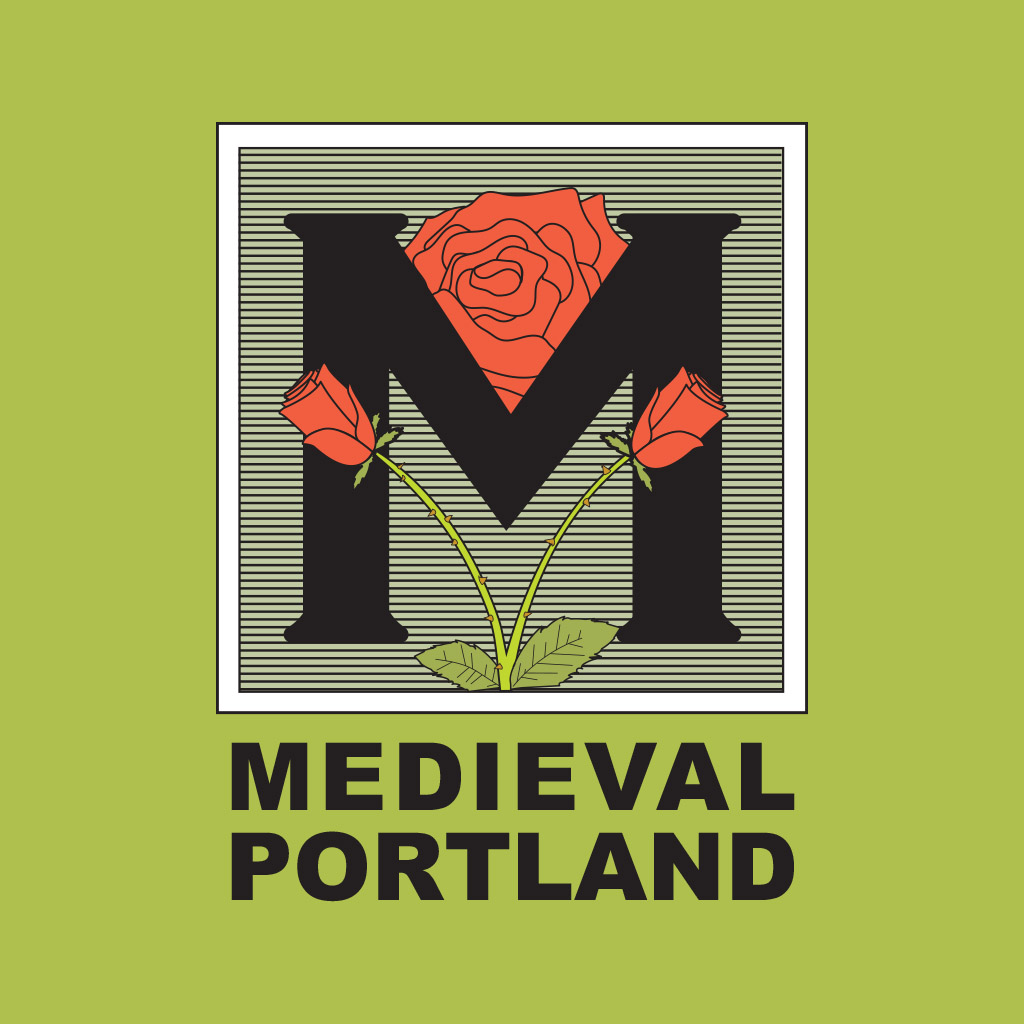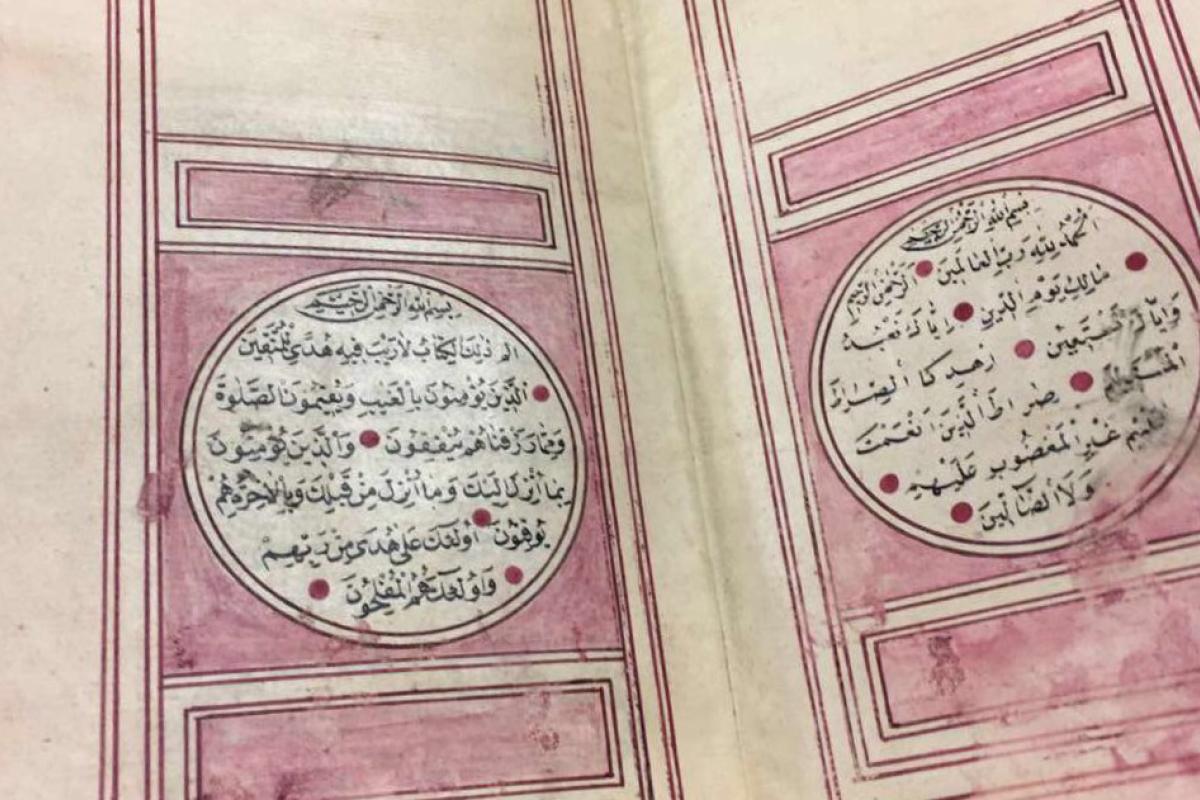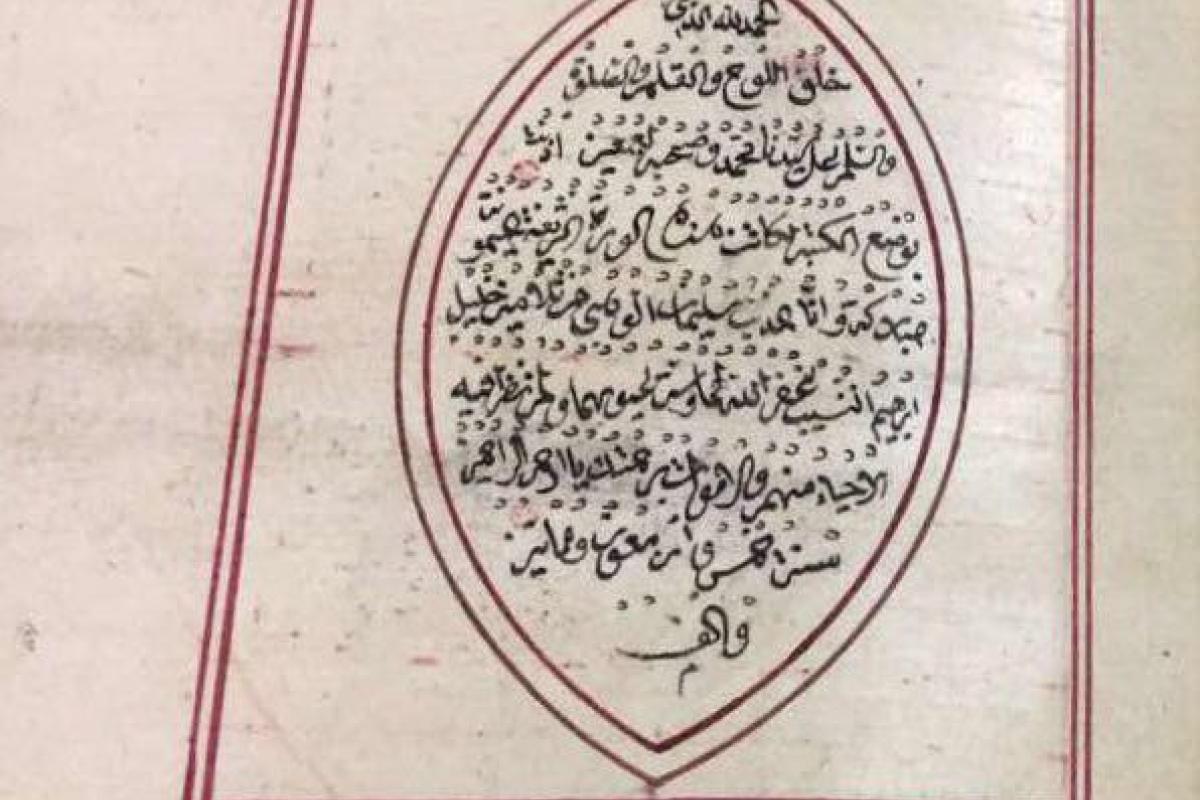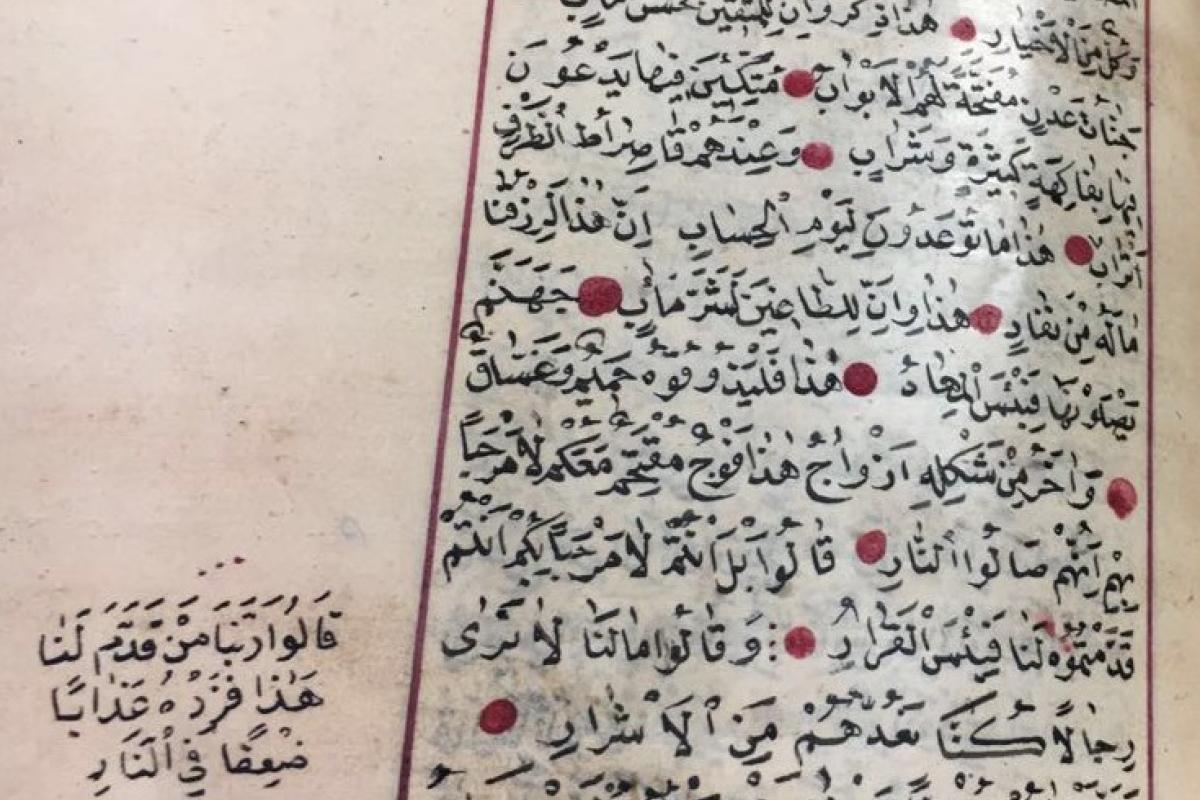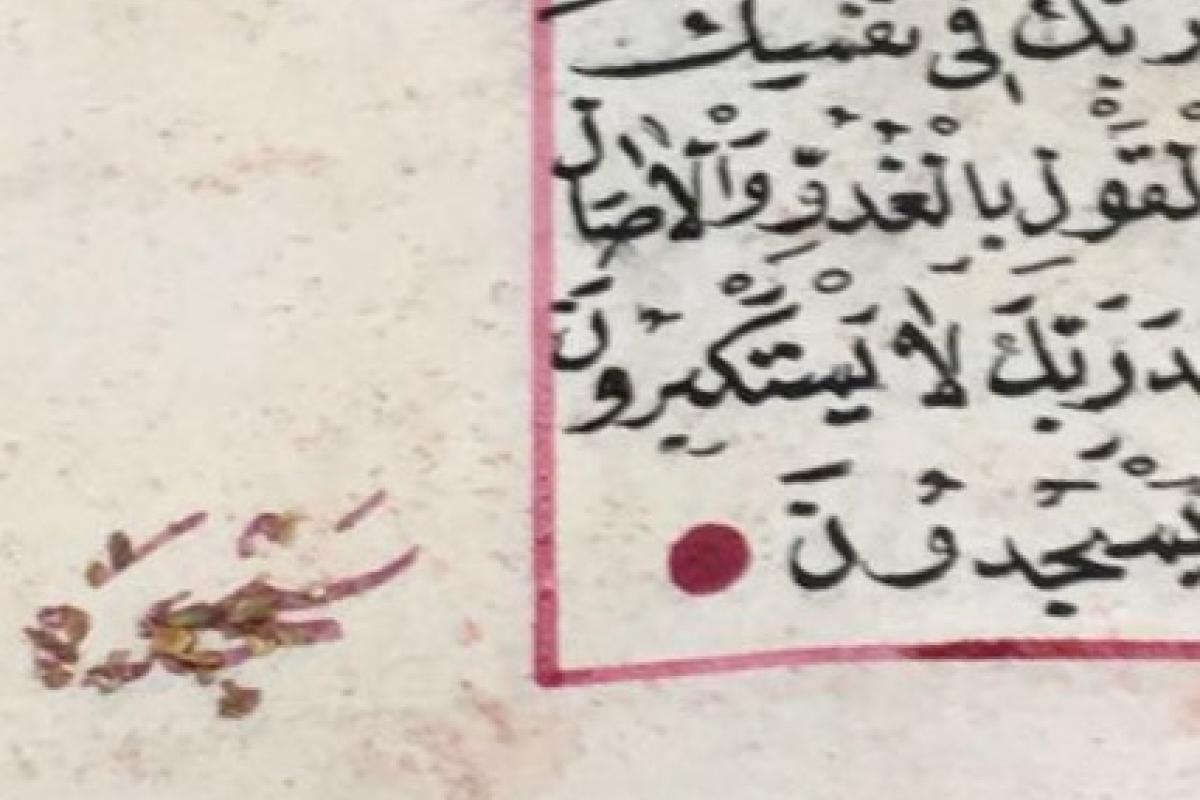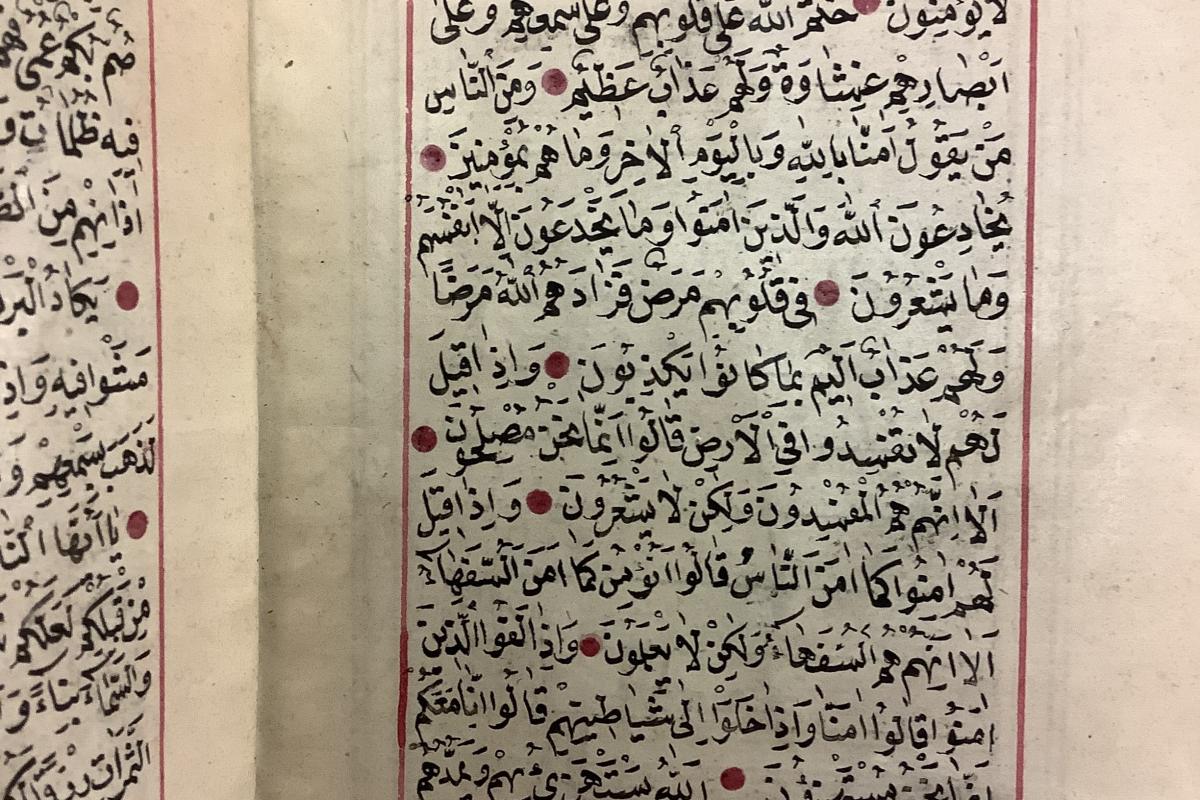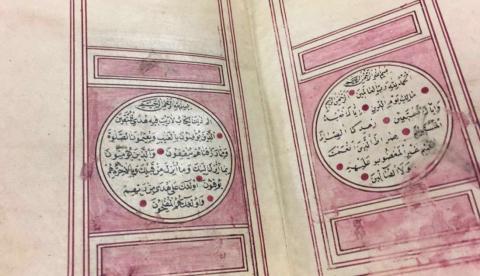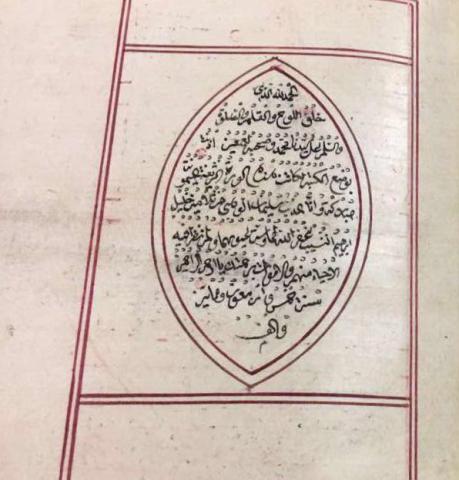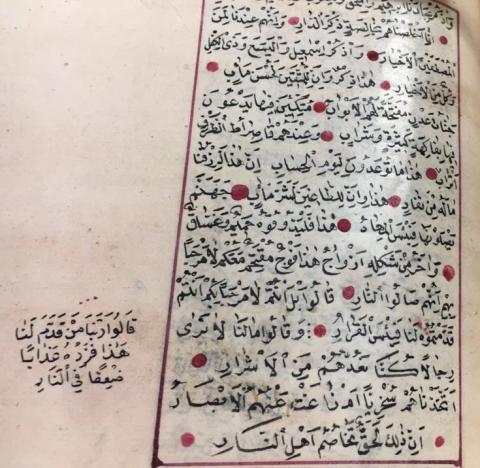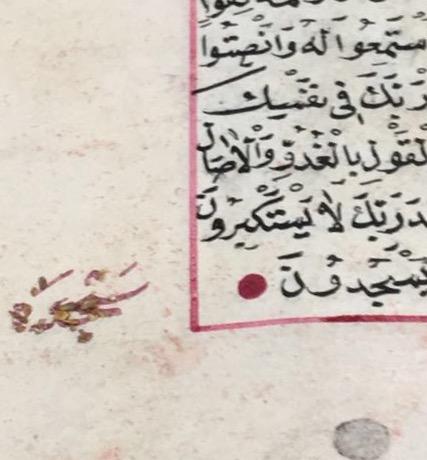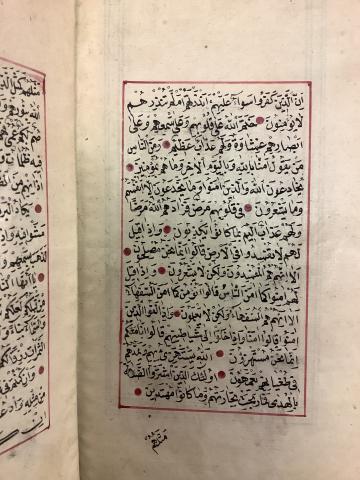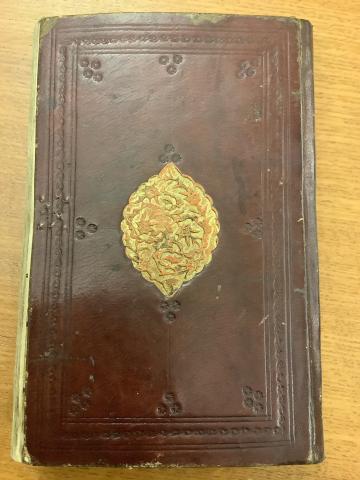Ibn Suleiman Qur'an
Ibn Suleiman Qur'an
Islamic, ca. 1832
Artist/Author: (?) Suleiman alw(?)ly
Language: Arabic
The Qur’an is in good condition. The binding is a 19th-century original made of brown leather. At its center is a golden lemon-shaped object. It is embedded with an ornamental design carved on a leather plaque. At the end of the Qur’an, there is a short prayer written by the Calligrapher, along with his name and the name of his teacher.
Multnomah County Library, John Wilson Special Collections
Khalid Alshaikh, Medieval Portland Capstone Student. 2016
Description of the Text
Ibn Suleiman’s Qur’an is a 19th-century Qur’an housed in the John Wilson Special Collections at the Multnomah County Library. John Wilson, an avid book collector, acquired it in London in November 1882, paying 21 pounds sterling. At the end of the book, there is a note attached to it with a quotation from a 19th-century book titled The Reminiscences of a Bashi-Bazouk by Edward Vizetelly. The quotation refers to Muslim beliefs regarding the Qur’an.
As with most Qur’ans, the first two pages of Suleiman’s work are decorated differently than the rest of the manuscript. Quranic Scholar Keith Small explained that these incipit pages’ purpose was “to awe readers and to immediately direct their attention to the glory of God and the divine glory of his book.”[1] The initial chapters’ text is placed within a circle, which itself is part of a carnation pink square. Two rectangles appear above and below those chapters. However, the rest of the Qur’anic text is placed within a carnelian frame. Two horizontal straight lines separate chapters from each other, and the individual Qur’anic verses are separated from each other by red dots. On the margins, a word might appear indicating the group of the Qur’an, such as Hizb (حزب), the part of the Qur’an, known in Arabic as Juz' (جزئ), or asking the reader to prostrate which reads in Arabic as Sajda (سجدة). Although these words were illuminated in the past, only traces of the golden font can now be observed.
Authorship
According to the colophon, the Ibn Suleiman Qur’an was finished in 1245 A.H (1829-1830 CE). It was written by the calligrapher ibn Suleiman (the son of Suleiman), who was a pupil of Ibrahim Al-Nasib, a calligrapher whose students wrote many of the Qur’ans in the 19th century. Among his students were Hasan Al-Basri, who produced a Qur’an in 1855,[2] and Hasan al-Kamili, who wrote a Qur’an in 1853.[3] According to sources, both were residents of the Ottoman Empire, with the former appearing to be from the city of Basara (based on his last name), while the latter is identified as a Turkish calligrapher). This is the first hint that the Ibn Suleiman Qur’an was produced in the Ottoman Empire. Nonetheless, the colophon of the Quran was written in a Diwani script. Ali Ayed Alshahrani, a linguist at King Khalid University, explained that the Diwani script was developed in the 16th century to produce official documents at state departments and institutions within the Ottoman Empire.[4] Therefore, it is clear that the Ibn Suleiman Qur’an was written in the Ottoman Empire.
The Script
The Ibn Suleiman Qur’an was written in the Naskhi script. Examples of the Naskhi script can be found in the 8th century, but it did not appear in a more organized way until the late 800s. Two figures helped the advancement of the Naskhi Script: Ibn Muqlah (d.940 CE) and Ibn al-Bawwab (d.1022 CE). The latter transformed the Naskhi script into “a script worthy of the Qur’an.” Consequently, the Naskhi script started to replace the Kufic script, which was the dominant script of the Qur’an in the first 300 years.[6]
According to Yasser Tabbaa, an expert on Islamic art, the Naskhi script became the preferred style for small Qur’ans during the Ottoman period.[7] All of the holy text in the Ibn Suleiman Qur’an were transcribed in the Naskhi script. Careful examination of the 19th-century Qur’ans reveals that some scribers choose not to name the chapters.[8] By the time this Qur’an was produced, the Naskhi script dominated the Qur’an writing business, and other scripts such as Thuluth, Muhaqqaq, and Rihani were no longer in extensive use.[9]
To assist the reader's pronunciation of the words, Ibn Suleiman added Arabic diacritics. This system of diacritical marks, which is called Tashkil, was invented and developed in the late 7th and early 8th century.[10] Over the years, many scribes of the Qur’an incorporated this system into their Qur’an. The ink base of the text is most likely carbonized lamb's wool mixed with water and a tiny bit of oil and soap as an emulsifier, as claimed by the former observer of the Ibn Suleiman Qur’an, Daniel O'Donnell.[11]
Oral Tradition
One of the striking things to notice from the first pages of the Ibn Suleiman Qur’an is the difference in the order of the verses between the contemporary Saudi Qur’an and this Qur’an. For instance, the first verse in Chapter 2 of the Saudi Qur’an reads “A.L.M (الَمَ ).”[12] On the other hand, the Ibn Suleiman Qur’an’s first verse of the same chapter reads, “ A.L.M this is the Book; in it is guidance sure, without doubt, to those who fear Allah (الم ذَلِكَ الْكِتَابُ لاَ رَيْبَ فِيهِ هُدًى لِّلْمُتَّقِينَ ).” Another remarkable difference is in chapter 27 of the Qur’an. In verse 33, the Saudi Qur’an reads “They said, "We are men of strength and of great military might, but the command is yours, so see what you will command" (قَالُوا نَحْنُ أُولُو قُوَّةٍ وَأُولُو بَأْسٍ شَدِيدٍ وَالْأَمْرُ إِلَيْكِ فَانظُرِي مَاذَا تَأْمُرِينَ ).”[13] In contrast, verse 33 in the Ibn Suleiman Qur’an reads “We are men of strength and of great military might (قَالُوا نَحْنُ أُولُو قُوَّةٍ وَأُولُو بَأْسٍ شَدِيدٍ).”
In the present day, there are two main canonical methods of reciting the Qur'an. The first is the reading of the Qur’an, according to Hafs. The other main tradition is the Warsh ‘an Nafi tradition that is popular in North Africa.[14] Since the publication of the standard Egyptian Qur’an (1924), which relied on Hafs’ transmission of the Qur’an, the Hafs ‘an Asim tradition became the dominant tradition and the world's most widely read Qur’an.[15] The differences between the two recitations could even alter the meaning of the verses in some cases. After comparing and contrasting the different verses with each other, it becomes clear that the Ibn Suleiman Qur’an transcribes the Hafs ‘an Asim tradition, just like the Saudi Qur’an. However, it is worth mentioning that it differs from the Saudi Qur’an in the numbering of verses on many occasions, as illustrated by the two examples mentioned above.
Audience
Uncovering the audience of this Qur’an is not an easy task. However, several hints within it may indicate who the audience was not. Some mistakes occurred in the Qur’an written by Ibn Suleiman. In some instances, there are missing verses which the writer rewrote on the margin of the pages. For example, in chapter 37, verses 91 and 92 are dropped from the text and were added by the writer in the margins. The Qur’an lacks aesthetic appeal, such as illumination and gilding, compared with other luxury 19th-century Ottoman Qur’ans. Furthermore, It did not contain the name of the chapters as it is commonly done by many Qur’ans of the time.[16] Therefore, this Qur’an was not produced for high-ranking statesmen or city mosques. Perhaps it was produced for a local town mosque or an Imam of a small mosque in the Ottoman Empire. For whatever purpose Ibn Suleiman’s Qur’an was fashioned for, John Wilson thought it was a valuable piece to add to his collection.
Notes
[1] Keith E. Small, Qurans, Books of Divine Encounters (Oxford : Boldleian Library, 2015), 54.
[2] Muraqqa. "1855 Antique Ottoman Illuminated Quran Koran Manuscript Calligraphy Muraqqa” http://www.ebay.com/itm/1855-ANTIQUE-OTTOMAN-ILLUMINATED-QURAN-KORAN-MANUSCRIPT-CALLIGRAPHY-MURAQQA-/121992428908, May 24, 2016.
[3] The Arabic reads:” Hassan Al Kamili was a Turkish Calligrapher who was a student of Ibrahim al-Nasib. From his work was a decorated and illuminated Quran which was written in the Naskhi script; documented to be from the year 1270[A.H]. It is kept in the al-Kamil group at Mecca’s library. http://www.mazameer.com/vb/showthread.php?t=134344&page=37&p=1758490&viewfull=1#post1758490, 2013.
[4] Ali Ayed Alshahrani, Arabic Script and the Rise of Arabic Calligraphy (Newcastle University, 2008), 18.
[5] Yasin Safadi, Islamic Calligraphy (Colorado: Shambhala Publication, 1979), 19.
[6] Ibid, 10.
[7] Yasser Tabbaa, "The Transformation of Arabic Writing: Part I, Qur'ānic Calligraphy." Ars Orientalis 21 (1991): 119-48.
[8] For example, two out of three 19th-century Ottoman Qur’ans in this page did not have the name of the chapters http://islamic-arts.org/2011/quran-folios-at-the-smithsonians-museums-of-asian-art/
[9] M.J. Alhabeeb, The Development of The Arabic Script: A Brief History, http://people.umass.edu/mja/history.html, 2005.
[10] Yasin Safadi, Islamic Calligraphy (Colorado: Shambhala Publication, 1979), 13.
[11] A three-page document of his observations (dated April 2004) on the Ibn Suleiman Qur’an can be found in the office of the John Wilson special collections. The Librarian believes he is an expert on Arabic.
[12] Uthman Taha, Holy Qur'an (Medina: King Fahd Complex for the Printing of the Holy Quran, 2003), 2.
[13] Ibid, 379.
[14] Ibn Warraq, Which Koran? Variants, Manuscripts, Linguistics (New York: Prometheus Books,2008), 45.
[15] Ibid, 45.
[16] This is an example of an Ottoman Qur’an from the 19th century. The name of the chapters was written in white ink. https://medias.expertissim.com/media/cache/media_zoom/uploads/object/2012/05/11/12131593/coran_ottoman2_4N.jpg
Bibliography
Al-Habeeb, M.J. "The Development of The Arabic Script: A Brief History." M.J AlHabeeb's Arabic Calligraphy & Painting. M.J. Alhabeeb, 2005. Web.
Alshahrani, Ali A. "Arabic Script and the Rise of Arabic Calligraphy." Online Submission. Institute of Education Sciences, 06 May 2008. Web.
Baker, Colin. Qur'an Manuscript: Calligraphy, Illumination and Design. London: British Library, 2007. Print.
Bayani, Manijeh, Anna Contadini, and Tim Stanley. The Decorated Word: Qur'ans of the 17th to 19th Centuries. London: Nour Foundation in Association with Azimuth Editions and Oxford UP, 1999. Print.
Small, Keith E. Qur'āns: Books of Divine Encounter. Oxford: Bodleian Library, 2015. Print.
Tabbaa, Yasser. "The Transformation of Arabic Writing: Part I, Qur'ānic Calligraphy." Ars Orientalis 21 (1991): 119-48. Web.
Taha, Uthman. Holy Qur'an ( Saudi Version ). Medina: King Fahd Complex for the Printing of the Holy Quran, 2003. Print.
Warraq, Ibn. Which Koran?: Variants, Manuscripts, Linguistics. Amherst, NY: Prometheus, 2008. Print.
Yasin, Safadi. Islamic Calligraphy. Colorado: Shambhala publication, 1979. Print.
